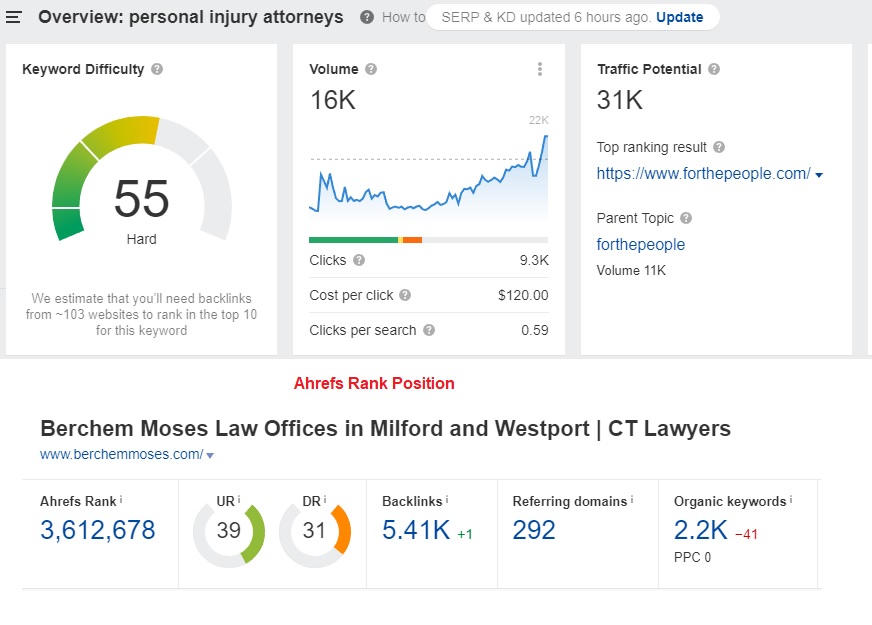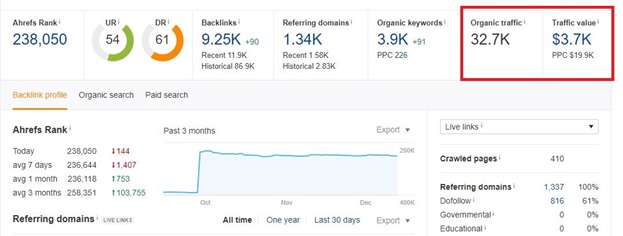If you’re looking to improve your website’s visibility and attract more relevant traffic, implementing a strategy of how to identify keywords is essential.
The video below is an overview of this article on how to identify keywords. If you just need a refresher this 3 min video is for you.
The importance of search intent and keywords
Search intent and keywords are essential components of any successful SEO strategy. Search intent refers to the reason why a user is conducting a search, whether it be to find information, make a purchase, or locate a specific website.
Understanding search intent is critical because it allows businesses to tailor their content to meet the needs of their target audience.
Keywords, on the other hand, are the specific terms or phrases that users type into search engines to find what they’re looking for.
By identifying and targeting the right keywords, businesses can increase their visibility in search results and attract more relevant traffic to their website.
Together, search intent and keywords form the foundation of effective SEO, enabling businesses to connect with their target audience and drive more conversions.
The purpose of the blog post
The purpose of this blog post is to provide a comprehensive guide on how to identify keywords for search intent that ranks. The blog post aims to help businesses and marketers understand the importance of search intent and how it plays a critical role in developing an effective SEO strategy.
By providing a step-by-step approach, this blog post will guide readers through the process of identifying the right keywords that align with their target audience’s needs and search intent and help them create content that resonates with their target audience.
The goal of this blog post is to empower businesses and marketers to improve their website’s visibility in search results, drive more relevant traffic to their website, and ultimately increase conversions.
How To Identify Keywords By Understanding Search Intent

Definition of search intent
Search intent (or user intent, audience intent) is the term used to describe the purpose of an online search. It’s the reason why someone conducts a specific search.
Yoast
Search engines like Google aim to provide the best results possible to users based on their search intent. For example, a user searching for “best hiking shoes” has the intent of finding recommendations for the most comfortable and durable hiking shoes.
Understanding search intent is crucial because it helps businesses create content that aligns with what their target audience is looking for.
By providing content that satisfies the user’s search intent, businesses can improve their website’s visibility in search results and attract more relevant traffic, ultimately leading to more conversions.
Types of search intent (navigational, informational, commercial, transactional)
There are four types of search intent:
- Navigational – refers to when a user is searching for a specific website or web page, such as searching for the homepage of a particular brand
- Informational – refers to when a user is seeking information on a particular topic, such as “how to make pizza dough.”
- Commercial – is when a user is researching a product or service with the intent to purchase, such as “best vacuum cleaner for pet hair.”
- Transactional – is when a user is ready to make a purchase or take a specific action, such as “buy iPhone 13.”
Understanding these types of search intent is essential for developing content that aligns with a user’s search intent and addressing their needs.
By creating content that satisfies the user’s search intent, businesses can increase the likelihood of their content ranking higher in search results, driving more traffic to their website, and ultimately increasing conversions.
Importance of understanding search intent
Understanding search intent is crucial for any business or marketer who wants to improve their website’s visibility in search results and attract more relevant traffic.
By understanding a user’s search intent, businesses can create content that aligns with their target audience’s needs and interests.
For example, if a user is searching for “best vegan restaurants,” they are likely interested in finding vegan restaurants in their area, and businesses that offer vegan options can create content that highlights their offerings to attract these users.
Understanding search intent also enables businesses to optimize their content for search engines and improve their website’s ranking in search results.
By providing relevant and high-quality content that satisfies the user’s search intent, businesses can establish themselves as an authority in their industry, attract more organic traffic, and ultimately drive more conversions.
Overall, understanding search intent is very important for developing an effective SEO strategy and connecting with a target audience.
Identifying target audience

Identifying the audience
Identifying the target audience is a critical step in developing an effective SEO strategy that aligns with search intent. To identify the target audience, businesses need to understand who their ideal customers are and what their needs and interests are.
This information can be obtained through market research, customer surveys, and analyzing web analytics data.
By identifying the target audience, businesses can tailor their content to meet the specific needs and interests of their target audience, including the type of content they prefer and the language and keywords they use when searching.
This enables businesses to create content that resonates with their target audience, improve their website’s relevance in search results, and drive more organic traffic.
Identifying the target audience is a very important step in developing an effective SEO strategy that aligns with search intent and helps businesses achieve their marketing goals.
Determining the needs of the audience
Once the target audience has been identified, the next step is to determine their needs and interests. To determine the needs of the audience, businesses can use various methods such as conducting surveys, analyzing web analytics data, and researching industry trends.
By determining the needs of the audience, businesses can create content that aligns with what their target audience is looking for and addresses their pain points.
This can include creating content that provides information on a particular topic, reviews of products and services, or guides that help solve specific problems.
By providing content that meets the needs of the audience, businesses can improve their website’s relevance and credibility, attract more organic traffic, and ultimately drive more conversions.
Conducting keyword research that Identifies keywords that align with the audience’s needs
Conducting keyword research Explanation of keyword research
Keyword research is the process of identifying and analyzing the specific terms and phrases that users type into search engines when looking for information, products, or services.
The goal of keyword research is to identify the most relevant and high-volume keywords for a particular business or industry. This is accomplished by analyzing search volume data, competition, relevance, and other metrics to identify the keywords that are most likely to drive traffic to a website.
By conducting keyword research, businesses can develop an effective SEO strategy that aligns with search intent and improves their website’s visibility in search results.
Keyword research can also help businesses identify gaps in their competitors’ keyword strategies and find new opportunities to reach their target audience.
Tools for conducting keyword research

There are various tools available for conducting keyword research, ranging from free to paid options.
One of the most popular and well-known keyword research tools is Google Keyword Planner, which is a free tool that provides search volume data, competition levels, and keyword suggestions based on a particular industry or keyword.
Other popular keyword research tools include Ahrefs, SEMrush, Moz, and Ubersuggest. These tools offer more in-depth keyword research features, such as analyzing competitor keywords, identifying long-tail keyword opportunities, and providing detailed keyword metrics.
Additionally, there are also several free tools available, such as Google Trends, which provides insights into the popularity of particular keywords over time, and Answer the Public, which generates content ideas based on common questions related to a particular keyword.
The choice of keyword research tool ultimately depends on the specific needs and budget of the business or marketer. By leveraging these tools, businesses can conduct thorough keyword research and develop an effective SEO strategy that aligns with search intent and drives relevant traffic to their website.
Keyword metrics to consider (search volume, competition, relevance)
When conducting keyword research, there are several key metrics to consider to identify the most relevant and effective keywords. These include:
Search Volume: This metric refers to the number of times a particular keyword is searched in a given time frame, typically per month. High-search-volume keywords generally have more competition, while low-search-volume keywords may have less traffic.
Competition: This metric refers to the number of other websites and businesses targeting the same keyword. Highly competitive keywords may be more difficult to rank for, while less competitive keywords may be easier to target.
Relevance: This metric refers to how well a particular keyword aligns with the content and offerings of a business. Keywords that are highly relevant to a business are more likely to attract qualified traffic.
Cost-Per-Click (CPC): This metric is relevant for paid search campaigns, such as Google Ads. CPC refers to the amount that businesses must pay to bid on a particular keyword and appear at the top of search results.
By considering these keyword metrics, businesses can identify the most relevant and effective keywords for their SEO strategy. It is important to strike a balance between high search volume and low competition keywords while ensuring the keywords are highly relevant to the business’s offerings.
By optimizing for the right keywords, businesses can improve their website’s visibility in search results and attract more relevant traffic to their website.
Analyzing the competition

Analyzing the competition is a critical component of keyword research and SEO strategy. By understanding the competition, businesses can identify gaps in their keyword strategies and find new opportunities to attract relevant traffic to their website.
To analyze the competition, businesses should identify their top competitors and analyze their website’s content and keyword strategies. This includes identifying the keywords they are targeting, the type of content they are creating, and their overall approach to SEO.
By understanding the competition’s keyword strategy, businesses can find new keyword opportunities that their competitors may have overlooked, and develop content that addresses the needs and interests of their target audience.
Additionally, businesses can also use tools such as Ahrefs and SEMrush to analyze their competitors’ backlink profiles, which can provide insights into their overall SEO strategy and how they are building their online authority.
By conducting a thorough analysis of the competition, businesses can develop an effective SEO strategy that aligns with search intent and helps them stand out in a competitive online landscape.
Identifying competitors
Identifying competitors is a critical component of developing an effective SEO strategy. To identify competitors, businesses should start by conducting a search for their target keywords and analyzing the top-ranking websites.
These websites are often businesses that are competing for the same audience and share similar offerings. Additionally, businesses can use tools such as Ahrefs, SEMrush, or Google’s search results page to identify other businesses in their industry that are targeting the same keywords or audience.
It’s also important to consider indirect competitors, such as businesses that offer alternative solutions or products to the same audience. By identifying competitors, businesses can gain insights into their keyword strategies, content approach, and overall SEO tactics.
This can help businesses identify gaps in their own strategy and find new opportunities to stand out in a competitive online landscape.
Ultimately, by analyzing the competition, businesses can develop an effective SEO strategy that aligns with search intent and helps them connect with their target audience.
Analyzing competitors’ keywords
Analyzing competitors’ keywords is an important step in developing an effective SEO strategy. By analyzing the keywords that competitors are targeting, businesses can identify gaps in their own keyword strategy and find new opportunities to attract relevant traffic to their websites.
To analyze competitors’ keywords, businesses should start by conducting a search for their target keywords and analyzing the top-ranking websites.
Tools such as Ahrefs and SEMrush can also provide valuable insights into the keywords that competitors are targeting, including the search volume, competition, and relevance of each keyword.
Additionally, businesses should analyze the content of their competitors to see how they are incorporating these keywords into their content and how they are addressing the needs and interests of their target audience.
By understanding the keywords that competitors are targeting and how they are using them in their content, businesses can develop an effective keyword strategy that aligns with search intent and attracts more relevant traffic to their websites.
Identifying gaps in the competition’s keyword strategy

Identifying gaps in the competition’s keyword strategy is a crucial component of developing an effective SEO strategy. By identifying the keywords that competitors are not targeting, businesses can find new opportunities to attract relevant traffic to their websites.
To identify gaps in the competition’s keyword strategy, businesses should analyze their content and keyword approach. This includes identifying the topics and subtopics that they are not addressing, and the keywords that are not being targeted.
Additionally, businesses can use tools such as Google’s Search Console to identify the queries and keywords that are driving traffic to their competitor’s websites.
By identifying gaps in the competition’s keyword strategy, businesses can develop content that addresses the needs and interests of their target audience and targets relevant keywords that their competitors may have overlooked.
This can help businesses stand out in a competitive online landscape and attract more relevant traffic to their website. Ultimately, by identifying gaps in the competition’s keyword strategy, businesses can develop an effective SEO strategy that aligns with search intent and helps them connect with their target audience.
Mapping keywords to search intent
Mapping keywords to search intent is another essential component of developing an effective SEO strategy that aligns with the needs and interests of a target audience.
When you map keywords to search intent, businesses can create content that satisfies the user’s search intent and addresses their specific needs and interests.
This involves grouping keywords by search intent, such as informational, navigational, commercial, or transactional, and creating content that aligns with each intent.
For example, an informational keyword may require creating blog posts or guides that provide detailed information on a particular topic, while a commercial keyword may require creating product pages or landing pages that highlight the features and benefits of a particular product or service.
By mapping keywords to search intent, businesses can also address the buyer’s journey, creating content that targets users at different stages of the journey, from awareness to consideration to decision-making.
Grouping keywords by search intent
Grouping keywords by search intent is a critical step in developing an effective SEO strategy that aligns with the needs and interests of a target audience.
There are four main types of search intent: informational, navigational, commercial, and transactional, and each requires a different approach to content creation.
By grouping keywords based on search intent, businesses can create content that addresses the user’s specific needs and interests and improves their website’s visibility in search results.
For example, informational keywords are focused on providing users with information, and they often include phrases such as “how to,” “what is,” or “why.” These keywords require creating content such as blog posts, guides, or videos that provide detailed information on a particular topic.
Navigational keywords, on the other hand, are focused on finding a particular website or page, such as a brand or a product. These keywords require creating content such as landing pages, homepages, or about pages that provide information about the brand or product.
Commercial keywords are focused on researching a product or service with the intent to purchase, such as “best laptops for video editing.” These keywords require creating product pages or landing pages that highlight the features and benefits of a particular product or service.
Finally, transactional keywords are focused on taking a specific action, such as “buy iPhone 13.” These keywords require creating landing pages, product pages, or checkout pages that allow users to take a specific action.
Creating content that aligns with search intent
Creating content that aligns with search intent is a critical component of developing an effective SEO strategy that attracts relevant traffic to a website. By aligning content with search intent, businesses can create a positive user experience and establish themselves as an authority in their industry.
This involves creating content that satisfies the user’s search intent and addresses their specific needs and interests.
To create content that aligns with search intent, businesses should start by analyzing the search results for their target keywords and identifying the types of content that are ranking well.
This can help businesses understand the user’s search intent and the type of content that is most likely to satisfy their needs. Additionally, businesses should use the right keywords throughout the content, including in the title, headings, meta description, and body of the content.
It’s also important to consider the format of the content, as this can affect the user’s engagement and experience. For example, video content may be more effective for certain search intents, while others may require more in-depth and detailed written content.
Ultimately, creating content that aligns with search intent requires understanding the user’s needs and interests and providing them with the information and solutions they are looking for.
By creating high-quality content that satisfies the user’s search intent, businesses can improve their website’s visibility and relevance in search results, attract more relevant traffic, and ultimately drive more conversions.
Mapping keywords to the buyer’s journey
Mapping keywords to the buyer’s journey is an important component of developing an effective SEO strategy that targets users at different stages of the journey.
The buyer’s journey typically consists of three stages: awareness, consideration, and decision-making, and each stage requires a different approach to content creation.
At the awareness stage, users are looking for information and solutions to their problems or needs. This stage is typically associated with informational keywords, such as “how to” or “what is.”
Content created for this stage should be focused on providing helpful and informative content that addresses the user’s questions and concerns. This can include blog posts, guides, and educational content.
At the consideration stage, users are researching potential solutions and evaluating their options. This stage is typically associated with commercial keywords, such as “best” or “top-rated.”
Content created for this stage should be focused on highlighting the features and benefits of a particular product or service, and demonstrating how it can solve the user’s problem. This can include product pages, case studies, and comparison guides.
At the decision-making stage, users are ready to make a purchase or take a specific action. This stage is typically associated with transactional keywords, such as “buy” or “sign up.”
Content created for this stage should be focused on making it easy for users to take action and should include clear calls-to-action, product pages, and checkout pages.
By mapping keywords to the buyer’s journey, businesses can create content that addresses the user’s specific needs and interests at each stage of the journey. This can help businesses establish themselves as an authority in their industry, attract more relevant traffic to their website, and ultimately drive more conversions.
Conclusion
Search intent and keywords are critical components of developing an effective SEO strategy.
By understanding the search intent of their target audience and identifying the most relevant and effective keywords, businesses can create content that addresses the user’s specific needs and interests, improves their website’s visibility in search results, and ultimately drives more conversions.
By grouping keywords based on search intent and mapping them to the buyer’s journey, businesses can create a positive user experience and establish themselves as an authority in their industry.
Ultimately, by aligning their content with search intent and targeting the right keywords, businesses can improve their website’s relevance and credibility, attract more organic traffic, and achieve their marketing goals.
If you’re looking to improve your website’s visibility and attract more relevant traffic, implementing keyword research into your SEO strategy is a must.
By identifying the most relevant and effective keywords for your business, you can develop content that aligns with search intent, targets users at different stages of the buyer’s journey, and drives more conversions.
So, don’t wait any longer, take the time to conduct thorough keyword research, analyze the competition, and map keywords to search intent and the buyer’s journey.
By doing so, you can improve your website’s relevance and visibility in search results, and ultimately achieve your marketing goals.


